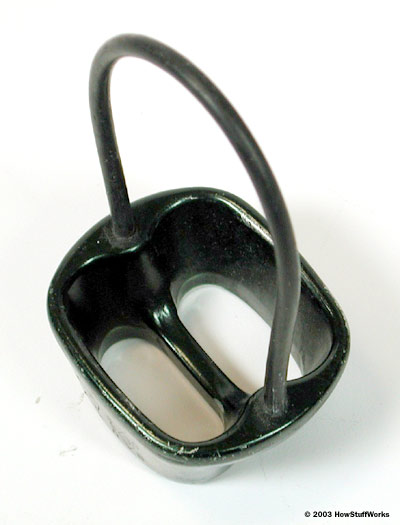
Image courtesy of Department of Defense
A U.S. Air Force Senior Airman ascends a climbing wall at Kirtland Air Force Base, NM.
Imagine a 1,000-foot tall sheet of vertical, continuous, seamless glass. If you had to climb it, it would be impossible unless you had suction cups for your hands and feet. Now imagine a 1,000-foot tall vertical rock wall filled with cracks and outcrops that are so obvious and so easy to find that you can climb it like you climb a ladder. Rock climbing always falls somewhere between these two extremes.
In the easy case there isn't really any skill involved at all. As long as a person is in decent physical shape, it's possible for just about anyone to climb a rock like this. As the rock gets smoother and the handholds get farther apart and smaller, the climber begins to enter the realm of nuance and finesse. The climber must be able to find adequate handholds and footholds, balance on them in often precarious positions, and move from one point to the next without falling. On difficult routes there can be thin cracks with little to grab hold of, overhangs that require incredible strength to traverse, and wind and temperatures that make the route up the rock even more challenging.
Whenever possible, the climber is trying to do most of the work of climbing using his/her legs. In the ideal case, climbers try to keep their centers of gravity over their feet and then push upwards with their legs. They use their arms and hands only for balance and positioning. As the rock becomes smoother, it becomes harder to stay in this ideal position. This is where strength and agility come in. On difficult routes, the climber needs incredible arm, hand and finger strength and endurance to stick to the rock. On extremely difficult routes, finding enough things to hold onto in a continuous sequence becomes a complex geometry problem. Check out the videos at SmithRock.com to see how strenuous climbing can get.
Rating System
In the United States, climbers use a standard rating system to describe the difficulty of different routes. There are 6 classes in this system, ranging from class 1 (normal walking) through hiking, scrambling and then climbing at class 5. Everything known as "rock climbing" falls in class 5. Class 6 is rock walls that are so smooth that there is no way to climb them without artificial aids like ladders.
Within class 5 there are 14 different levels that break down like this:
- 5.0 through 5.4 -- beginner level. Easy to climb, like a ladder.
- 5.5 through 5.7-- intermediate level. Climbable in normal shoes or boots but requiring more skill.
- 5.8 through 5.10 -- experienced level. Requires climbing shoes, experience and strength.
- 5.11 through 5.12 -- expert level. Perhaps only the top 10% of climbers in the world can handle these routes.
- 5.13 through 5.15 -- elite level. Can only be handled by the best of the best.
Probably the easiest and safest way to get started in rock climbing today is to go to an indoor climbing facility and take lessons. There you will learn the basic techniques in a safe environment, build your strength and skills, and meet other climbers. Any major city will have two or three climbing gyms in the area. Once you understand the basics, you can find a partner and head out to start on easy sport routes. As you gain experience, you can move up to more advanced routes.
Many climbers never move beyond sport climbing because they like the safety and speed of using pre-placed bolts. If you want to try advanced routes, or routes in remote areas, then you can learn how to place protection and try out traditional climbing. In making the jump to traditional climbing, it is essential to find a partner or hire a guide/instructor with traditional climbing experience so that you can learn how to safely place protection yourself.
Now you have an idea of how to get started. And, you've learned that there are several forms of rock climbing, and that each requires different levels of skill. Strength, stamina and control are integral to mastering the sport. Some other important aspects are the equipment and climbing technique. In the next section we'll take a look at the equipment and technique involved in sport climbing.








